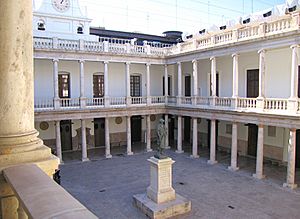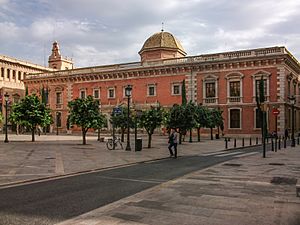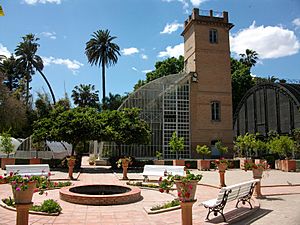University of Valencia facts for kids
|
Universitat de València
|
|
 |
|
| Type | Public |
|---|---|
| Established | 30 April 1499 |
|
Academic affiliations
|
Vives Network |
| Rector | Maria Vicenta Mestre Escrivà |
|
Academic staff
|
3,300 |
| Students | 65,789 (Total) |
| Undergraduates | 45,000 |
| Postgraduates | 8,000 |
| Location |
,
,
Spain
39°28′45″N 0°21′33″W / 39.47905110°N 0.35908730°W |
| Campus | Urban |
 |
|
The University of Valencia (also called UV) is a big public university in Valencia, Spain. It is one of the oldest universities in Spain. It is also the oldest university in the Valencian Community. Many people think it is one of the best schools in Spain.
The university started in 1499. Today, about 55,000 students go there. Most classes are taught in Spanish. However, the university plans to offer more classes in Valencian and English.
The university is in the city of Valencia. Valencia is the capital of the Valencian Community. It is also the third largest city in Spain. One of the university's campuses is in the towns of Burjassot and Paterna. The current leader of the university is María Vicenta Mestre Escrivá.
Contents
History of the University
How the University Started
In 1246, Pope Innocent IV allowed the creation of "general studies" in Valencia. This was asked for by James I the Conqueror. The rules for the university were set on April 30, 1499. This date is seen as the university's founding day. In 1501, Pope Alexander VI approved it. A year later, Ferdinand II the Catholic gave it royal permission.
The university was founded thanks to Vincent Ferrer and a building donation from Mosen Pedro Vilaragut. We do not have many records about how the university worked back then. From the start, students could study many subjects. These included Latin, Greek, Hebrew, and Arabic. They also studied philosophy, mathematics, physics, theology, Canon law, and medicine.
Growth and Important Discoveries
The late 1600s and all of the 1700s were a very good time for the university. Greek, Latin, mathematics, and medicine were especially popular. A famous student was Tosca, a physicist and mathematician. He was a friend of Evangelista Torricelli. People said it was the best university in Spain for math, humanities, philosophy, and medicine. Students even made large drawings of the human body.
Valencia was the first university in Spain to offer a course on studying plants. Many doctors who graduated from Valencia became famous. Pedro Ximeno found a small bone in the ear. He taught at Alcalá. Luis Collado, a botany professor, made important discoveries about plants in the area. Vicente Alfonso Lorente also wrote books about plants. The famous botanist Cavanilles also studied here.
Challenges and Changes
In the 1600s, the university had two groups with different ideas. These groups argued a lot. The university had a library with 27,000 books. Sadly, soldiers destroyed this library. A famous professor was D. Francisco Pérez Bayer. He was very smart and important during the time of Charles III of Spain.
Several colleges for poor students were built around the university. The first was started by St. Thomas of Villanova in 1561. Others followed, including one by Blessed Juan de Ribera. Philip II also started one. In 1938, during the Spanish Civil War, a fire badly damaged the library.
University Campuses
The University of Valencia has three main campuses. They are in Valencia city and in Burjassot-Paterna. There are also other buildings in the center of Valencia. These include the Historic Building, the Botanical Garden, and the Rectorate. The university also has an astronomical observatory in Aras de los Olmos.
- The Burjassot Campus has colleges for Biology, Pharmacy, Physics, Chemistry, Mathematics, and Engineering.
- The Avenida de Blasco Ibañez Campus has schools for Medicine, Dentistry, Philosophy, Psychology, Geography, History, and more. It also has schools for Physical Education, Physiotherapy, and Nursing.
- The Tarongers Campus has schools for Law, Economics, Business, and Social Sciences. The School of Elementary Teacher Training also moved here recently.
Schools and Faculties
The University of Valencia has 18 Schools and Faculties. They are on its three main campuses. Each school has different departments. They offer programs for undergraduate, master's, and PhD degrees.
Studying at the University of Valencia
The University of Valencia offers degrees in many subjects. These include Arts, Humanities, Engineering, Health Sciences, Science, and Social Sciences.
Students can study in other countries through exchange programs. These programs are with universities in Europe, North America, Latin America, and Asia. The university is one of the top ten in Europe for student exchanges. It also works with International Studies Abroad. This helps students from the United States and Canada study there.
Research at the University
Research is done in several ways at the university. This includes academic departments, research institutes, and the Science Park.
Research Institutes are special groups that do many types of research. They work to meet the needs of society and businesses. They focus on research and sharing new knowledge.
Notable People from the University
Famous Teachers
- Juan José Martí (1570–1604) — a writer and lawyer.
- Santiago Ramón y Cajal (1852–1934) — won the Nobel Prize in Physiology or Medicine in 1906.
- Dámaso Alonso (1898–1990) — a poet and literary expert.
- Ernest Lluch (1937–2000) — an economist and politician.
- Álvaro López-García (1941–2019) — an astronomer.
- Carmen Aranegui (born 1945) — an archaeologist.
- Carles Solà (born 1945) — a chemist and university leader.
- Josep Guia (born 1947) — a mathematician.
- Jon Juaristi (born 1951) — a poet and writer.
Famous Graduates
Arts and Science Graduates
- Juan Luis Vives (1493–1540) — a smart scholar from the Renaissance. He is called the father of modern psychology.
- Joseph Calasanz (1557–1648) — a priest.
- Juan Tomás de Rocaberti (1627–1699) — a theologian.
- Mathieu Orfila (1787–1853) — a toxicologist. He started the science of toxicology.
- Graciano López Jaena (1856–1896) — a journalist from the Philippines.
- José Martínez Ruiz (1873–1967) — a writer and literary critic.
- José Gaos (1900–1969) — a philosopher.
- Isabel-Clara Simó (1943–2020) — a journalist.
- Rafael Ninyoles i Monllor (1943–2019) — a sociolinguist.
- José Luis Soberanes (born 1950) — a lawyer from Mexico.
- Amparo Acker-Palmer (born 1968) — a Spanish cell biologist and neuroscientist.
- Josep Carles Laínez (born 1970) — a language expert.
- Carlos Alós-Ferrer — an economist.
- Etelvina Andreu — a physicist, doctor, and politician.
- José-Miguel Bernardo — a mathematician and statistician.
- Marti Bonmati Luis — a medical doctor.
- Estrella Durá — a psychologist and politician.
- María Ángeles Durán — a sociologist.
- Pablo Jarillo-Herrero — a physicist.
- Andrés Piquer — a doctor and philosopher.
- Antoni Roig Muntaner — a chemist.
- Manuel Sánchez Ayuso — an economist and politician.
- Daniel Tordera — a chemist.
- Hassan Ugail — a mathematician.
- Muriel Villanueva i Perarnau — a writer.
- Antonio Vidal-Puig — a medical doctor and scientist.
- Aquilino Cayuela — a writer and professor.
- Carmen Agulló Díaz — a professor and author.
- Jorge Mateu — a mathematician and author.
- Juan José López-Ibor — a psychiatrist.
Politics Graduates
- Gabriela Bravo — a politician.
- Gema Climent — a scientist and tech business owner.
- Esther Herranz García (born 1969) — a politician.
- Belén Hoyo Juliá — a politician.
- Joan Lerma — a politician.
- Enrique Monsonís — a politician.
- María Sornosa Martinez (born 1949) — a politician.
- José Manuel Vela Bargues (1962–2022) — an economist and politician.
- José Viñals (born 1954) — an economist.
University Rankings
| University rankings | |
|---|---|
| Global – Overall | |
| ARWU World | 201–300 (2024) |
| QS World | 445 (2025) |
| THE World | 501–600 (2024) |
| USNWR Global | 212 (2023) |
See also
 In Spanish: Universidad de Valencia para niños
In Spanish: Universidad de Valencia para niños
- Vives Network
- List of medieval universities
- Route of the Borgias







